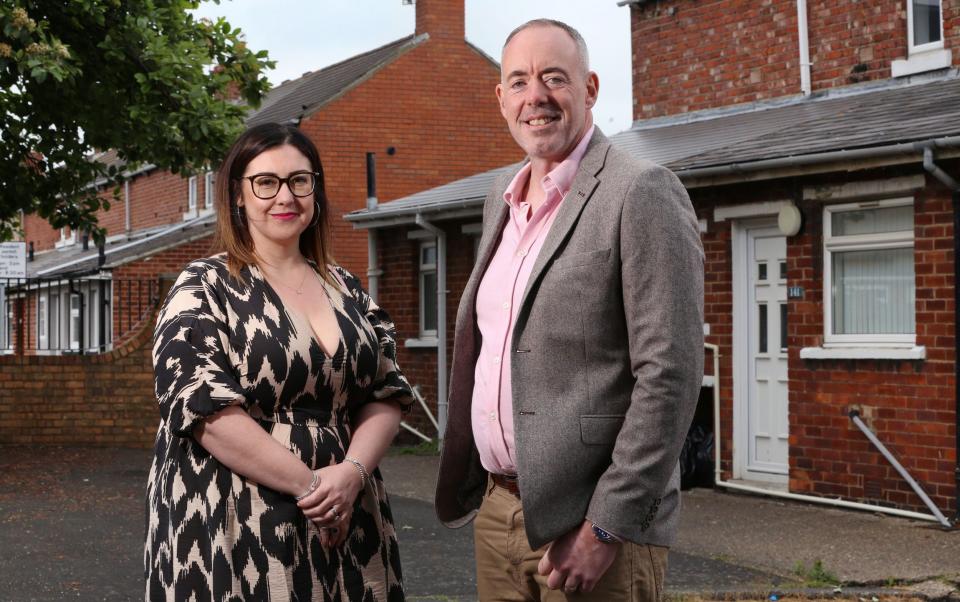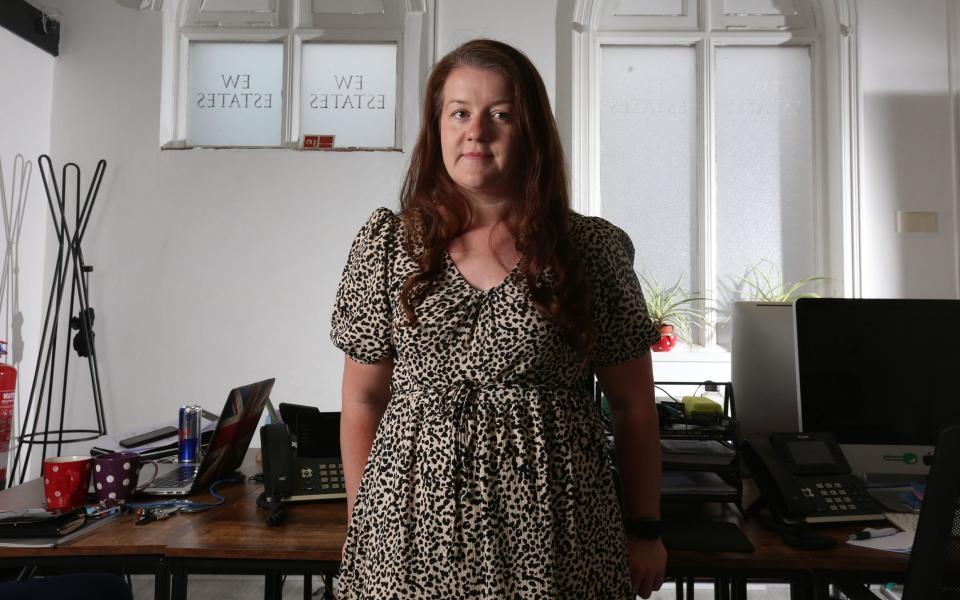‘My property empire is booming in the only place where buy-to-let Britain isn’t dying’

Paul Baldry is the son of a coal miner but now owns over 100 properties in and around Ashington, an former pit town 15 miles north of Newcastle, and famous as the home of the England footballers Jack and Bobby Charlton.
“It seemed very grey here as a kid”, he says. “Now the call centres have taken over. They’re like the pits of the modern age – people love the Geordie accent.”
Baldry, 44, is one of thousands of landlords investing in north-east England, which is bucking the trend as the rest of Britain’s property market goes into reverse after years of booming house price growth.
When Baldry turned his hand to buy-to-let investing, he was working full-time in a hospital doing maintenance shift work.
He bought four properties in his first week as a landlord. “I didn’t get much sleep after that.”
By 28, Baldry was in a position to retire, having become something of a success story in his town.
But early retirement didn’t last long. After buying a convertible Porsche he bought with his newfound rental returns, boredom quickly set in.
After just six weeks off, Baldry launched an estate agency and opened franchise offices in Norwich, Leicester, and west London.
Nearly 20 years on, Baldry owns a third of the houses in the street he lives on. He says he has achieved rental yields of between 12 to 14pc on average throughout his career, and demand for housing in his area just keeps on rising.
“We had 96 people apply to rent a property in Ashington before the tenant was even out of it,” he says.

A new railway station is being built in Ashington, 60 years after the original station was a victim of the Beeching cuts, and will bring yet more people to the town.
Despite the tougher market facing buy-to-let investors, Baldry says he hasn’t sold a property since the 2007 financial crash.
“The market will always bounce back”, he says. “You have to be patient. I’ve got another four crashes in me before I’m buried.”
‘What happens in London is not gospel’
Buy-to-let landlords in the south of England have been ringing the death knell on their sector for years now. But investors in the North East aren’t so pessimistic.
Net zero eco upgrades, interest rates rises, tax relief cuts and, most recently, rental reforms tightening rules on evictions have slowly squeezed the number of landlords operating across Britain.
Rising interest rates have also been eating into homeowners’ incomes and stalled new house sales as buyers realise they can no longer afford the same properties – prompting fears of a house price crash.
But like her husband, Natalie Baldry, 40, is reassured by the local housing market. She doesn’t think prices outside of London move as dramatically and is comforted by the cushion of buying at far lower prices.
“If you’re buying a house for £60,000, you won’t lose much [even if there is a crash]“, she says.
Michael Mortimer, 33, is another landlord from the North East. He owns a small handful of properties in Newcastle, and also operates an estate agency.
He says: “Every housing crash is different. London’s miro-climate is often mapped onto the rest of Britain.
“Messaging on a potential crash is often London-centric, whereas elsewhere in the UK it’s a very steady, normal market. A lot of property investors take the London narrative as gospel, and it’s really frustrating.”

He also says there is a new generation of landlords entering the market. One which is ready to brace for higher interest rates, and happy to put up more capital to avoid the fate an older generation of over-leveraged landlords find themselves in – particularly across the South – who are now being forced out of the market.
In pockets of the North East, pouring more money into properties and taking out smaller loans is entirely possible with flats selling as cheaply as £50,000.
In the first three months of 2023, sales agreed across the North East were up 7pc compared to the start of 2019, making the region the strongest performing property market in the country, according to data company TwentyCi.
A big part of this is down to consistently higher rental yields in the region. Across the entirety of the North East, rental returns are 7.2pc on average, according to data firm Outra. This is compared to 4.4pc in London, and 4.8pc in the South East.
Over half of houses in the North East are worth less than £100,000, making these higher yields possible because of smaller mortgage outgoings.
Giles Mackay, founder of Outra, says affordability in the North East means the region will be “the quickest to recover” of any other area in the UK, amid a downturn in mortgage borrowing and lower sales.
Mr Mackay says: “It’s all about your ability to get a mortgage. The price-to-income ratio is the lowest in the North East.”
Interest rates have ‘spoiled rents’ in the North East
Phoebe Lenderyou, a business development manager for Coventry Building Society, says investors in the North East are not selling up yet and echoed what Baldry has seen – that tenant demand has gone up in areas such as Ashington.
Rising interest rates are, however, making it harder for some landlords to borrow in more expensive areas of the North East.
Lenderyou says a high-end flat priced at £160,000 in Newcastle and producing £700 a month in rental income would require a typical investor to borrow £125,000. Now, she is finding landlords are struggling to even borrow £100,000.
Investors who buy properties in their own name do have options to off-set mortgage costs against profits. More are converting to limited companies in an effort to become more tax efficient as a result, but this process can be costly and lengthy.
Smaller lenders, such as Foundation Home Loans, offer specialist products which aim to maximise how much landlords can borrow while still complying with “interest coverage ratio” rules.
As rents continue to creep up, charities such as Shelter have sounded the alarm over fears that rental arrears – and by extension homelessness – will rise nationally.
Karbon Homes, a housing association in Newcastle, says while it has not noticed a major rise in arrears yet, it has noticed a different demographic of tenants falling into arrears – those who do not have access to cost of living support because they earn too much.
Ms Baldry says regulation, compounded by rising interest rates, has “spoiled rents” for many tenants in parts of the North.
She cited one example of a property in Ashington where the landlord had not put the rent up in nearly 30 years. The property was recently sold to another landlord at auction, which saw the tenants’ rent more than treble – from £200 to £700 per month.
Since 2016, the Government has unleashed a barrage of damaging tax and regulation changes for landlords – including the introduction of a 3 percentage point stamp duty surcharge and a dramatic reduction in tax relief on buy-to-let mortgages.
More recently, net zero targets have placed an onus on landlords to spend thousands of pounds on energy improvements to make their properties more energy efficient.
Meanwhile, buy-to-let mortgage rates have risen to eye-watering heights. The average two-year fixed rate for landlords on offer as of June 6 was 5.98pc, according to Moneyfacts.
Not everything turns to gold in the North
It is common for southern property investors to buy properties in the North at auction. But because they have often never stepped foot in the properties, or know anything about the areas in which they are, this has led to some dud investments, say agents. While demand is high in the North East and stock is low, the calibre of tenants is variable.
Baldry says: “People in London see the North East as ‘that place up there’ where ‘everything you touch turns to gold’.
“Southerners don’t know the differences between odd and even numbered terraces, for example. They don’t know that there’s different amounts of space in these terraces. That’s why I only buy the even numbers, because they’re easier to let.”

Mortimer has seen southern investors lose out first hand. He says: “There is this misconception held by southern investors about rental yields in the North East.
“The region is not all one place. There are towns you should avoid.
“It’s often where demand is there from tenants, but the risk tenants might default is high, sometimes due to anti-social behaviour. In these areas, we’ll find every tenant we try to put through referencing has a CCJ [county court judgement] on their record.
A CJJ can be issued to a tenant who is evicted by their landlord using Section 8, which goes through the county court.
Mortimer says with the new Renters Reform Bill set to be enshrined in law, some landlord clients of his would rather keep their homes empty – and can afford to – when the alternative is potentially letting to a disruptive tenants they cannot evict.
As part of the new bill, levelling up secretary Michael Gove wants to get rid of Section 21 – a quicker way of evicting tenants which bypasses the court – and introduce rolling tenancies, which will make it harder to evict tenants, too.
Mortimer fears that in the North East, where landlords are less leveraged and more immune to income shocks, this will create an even bigger supply gap making it harder than it already is for tenants.
He says : “My clients are leaving properties empty and putting their rents up very high. It doesn’t matter if they aren’t filled, they don’t want a tenant they can’t get out.”
The planning system is also weighing on rental housing supply in the area. A colleague of Mortimer’s bought a site in Newcastle. The land has sat unused for two years since he bought it. He has now been told he can’t build on it after all.
Mortimer says: “After all that money spent changing plans and designs, it’s just going to waste.”
Young landlords are sensible
While there are fears of the great buy-to-let sell-off and how this will squeeze the rental market, landlords in the North East feel more optimistic about the younger investors coming into the space.
Mortimer says this next generation of landlords are aware of the very different climate they are coming into.
“They haven’t overleveraged themselves as much as last generation,” he says, “they don’t mind having some capital in property or paying to improve it.
“They’re also more selective about where they buy.”
Emma Walker, 32, of EW Estates in Ashington, says young landlords are more clued up on forecasting and “lots of creative investing” is happening to enable them to borrow what they need.
She says: “We’re seeing investors make use of lease options, rent-to-buy, and vendor financing [where sellers loan the buyers the deposit] which happens quite a bit. It’s not as simple as buying with cash or getting a mortgage anymore.”

Meanwhile, Walker says the older generation “wants out” and are coming to the end of their landlord careers.
Bruce Haagensen, 72, has been a landlord in Newcastle for 30 years. Made redundant as a banker and facing mounting bills with two children in private school, he turned to property investment.
He says: “There is no future for residential lets nationally. We have a situation currently where all parties perceive the way forward is to get rid of the private rental sector.”
With Labour around 15 points ahead in the polls, landlords fear what the future could bring.
Baldry says: “It’s a slow market to get into and out of. Even one term of a Labour government might prevent investors putting money into it. The UK market, once seen as a safe investment, may well not be in the future.”
Energy upgrade fears ‘overblown’
One reason landlords are leaving the buy-to-let market is because of incoming energy performance (EPC) rating targets. By 2028, Mr Gove wants all rental properties to be an EPC C or higher.
In the North East, 53pc of properties have a D rating, while 32pc are a C. Data firm Outra has warned that this could cost investors in the region dearly.
It says the spending needed to get properties in the area up to scratch will be a much bigger proportion of the overall value, hence hitting investors in the North East harder.
However, local landlords say differently. Walker is also a landlord. She has three properties she bought and refurbished back from brick.
She says: “EPC targets are not law yet, for one, it’s still a long way away and there will be some exemptions.
“Everybody is panicking prematurely. Some houses in this area definitely need to be brought up to date. But the cost of rectifying solid brick properties isn’t as big as you might think.
“Take a 1900, three-bed terrace in Ashington as an example. It won’t cost you £10,000 [the Government’s proposed cap on upgrade costs]. It’s already a high D, so needs minimal changes like roof insulation, which is a couple of hundred pounds.”

 Yahoo Finance
Yahoo Finance 